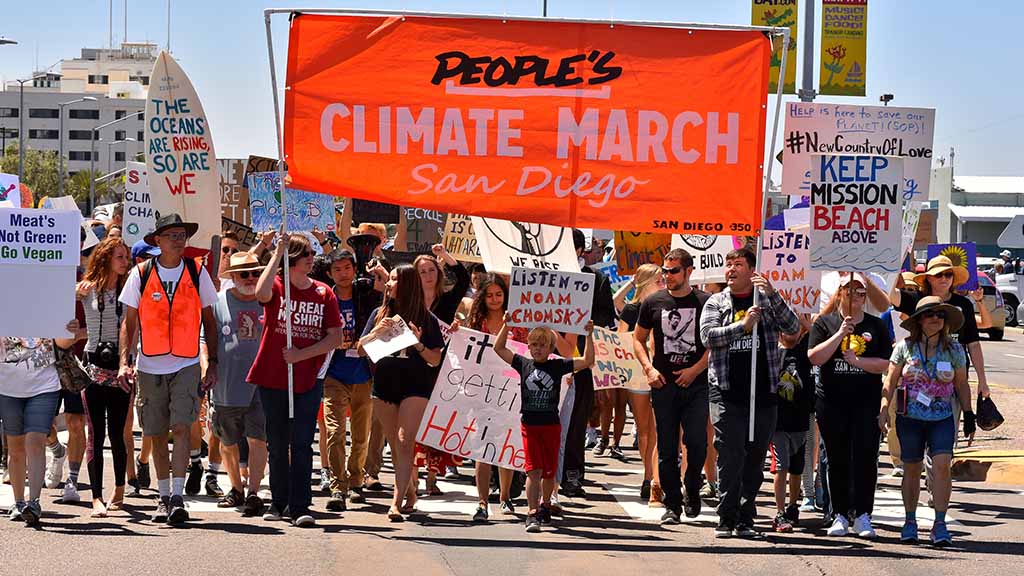This is the seventh and final blog in a series that communicates about climate change through personal stories. Over the course of three months, UCSD student Caitlin Crowe interviewed seven long-term beach goers in San Diego County on their personal connections with climate change effects. In this post we discuss what you can do to help combat climate change both individually and collectively.

Communicating the realities of climate change, with the complexity and uncertainty of specific effects is undoubtedly a difficult task. We need to begin to connect the science to how it will affect individuals and communities as time moves forward. More importantly, we need to engage in discourse about science in terms that are more easily comprehensible to people who are not scientists. This can be done by creating easier access to various forms of information. By making information easily accessible and connecting the science to people’s everyday lives, we are allowing the space to invite more voices to the table working to create more diverse and inclusive solutions to combat the climate change effects discussed in this blog.
In this final blog of the climate stories series, we discuss several ways you can get involved in combating climate change effects as well as provide resources to various organizations who are currently in the fight against climate change.
Community Action:
1. Community science and stewardship.
Support restoration and enhancement of coastal and watershed ecosystems through stewardship efforts such as planting natives, pulling weeds, and picking up trash from beaches, dunes, coastal wetlands, riparian corridors, and creeks. These ecosystems buffer storms, keep pace with sea level rise, stabilize sediments and improve water quality by slowing runoff, and provide habitat for a wide variety of native species. Also consider participation in any one of the growing number of community science efforts that engage communities in data collections. Support can come in the form of donations of time or money to organizations that conduct these efforts.
Here is a list of some local organizations and group chapters that provide volunteer opportunities throughout the year: San DiegoCoastkeeper, San Diego Surfrider, San Diego Canyonlands, Ocean Discovery institute, I Love a Clean San Diego, San Diego River Park Foundation. If you are not in the San Diego area, be sure to check out your local chapter of these groups: Surfrider, Coastkeeper, Coastal Cleanup Day and other locally based groups in your area. There are also several friends groups associated with lagoons up the coast- San Dieguito, San Elijo in particular.
2. Be a local science leader.
Volunteering as a docent at a local park, museum or reserve is a great way to give back and educate visitors through tours and creation of interpretive signs and other materials. Docents act as liaisons between what visitors already know and what they learn on the guided tours.
Here are some great local San Diego options: Tijuana River National Estuarine Research Reserve, Living Coast Discovery Center, Torrey Pines State Natural Reserve, Mission Trails Regional Park Visitor Center.
3. Reduce, reuse and recycle.
It’s an old phrase but is more meaningful than ever. Cutting down on the use of materials, especially single use products, saves energy and reduces pollution associated with the extraction of materials used for fabrication, the transport of materials and goods, and the challenges that come along with disposing of materials, including use of energy and production of pollutants. Something as simple as bringing reusable bags when grocery shopping or choosing paper bags over plastic bags can make a huge difference in reducing single use plastics which have been shown to release greenhouse gases, contributing to climate change. Use less. If you can’t, reuse goods. And if you can’t reuse, then recycle. Many steps along a products life cycle produce greenhouse gasses and pollutants- learning to live with less can help with this.
4. Support sustainable food movements.
Support local food movements, including getting involved with fair food system-based community groups, such as Slow Food Urban San Diego and the San Diego Food System Alliance. Also support local businesses who supply local food, and producers, managers and scientists who develop responsible strategies, to facilitate resilient, responsibly sourced fisheries and farms. Monterey Bay Aquarium’s Seafood Watch Program ranks seafood that’s fished or farmed according to the estimated amount of impact on the environment. California Sea Grant’s Seafood Profiles and NOAA’s FishWatch.gov are great resources to learn about the your favorite seafood and create your own ranking based on what is important to you.
5. Educate yourself.
Educate yourself on the costs and benefits of coastal management strategies and provide public comment to local decision makers. For example, creation of living shorelines and beach nourishment, another name for the addition of sand, have been used to reduce the impacts of climate change effects throughout San Diego. However, solutions can be complex and come at a cost to other benefits conferred from ecosystems and so should be explored in order to make informed decisions (13).
6. Become a climate activist.
One of the most effective and direct ways to combat the effects of climate change is to make your voice heard. Expressing your concern about climate change is critical in motivating both collective and political action. We are all experiencing climate change impacts in our daily lives, and it is an issue we can all talk about. There are many ways to show up for the fight against climate change such as attending organized events (marches, rallies, protests), signing petitions calling for climate action, or donating your time or money to organizations and climate action groups leading these efforts.




